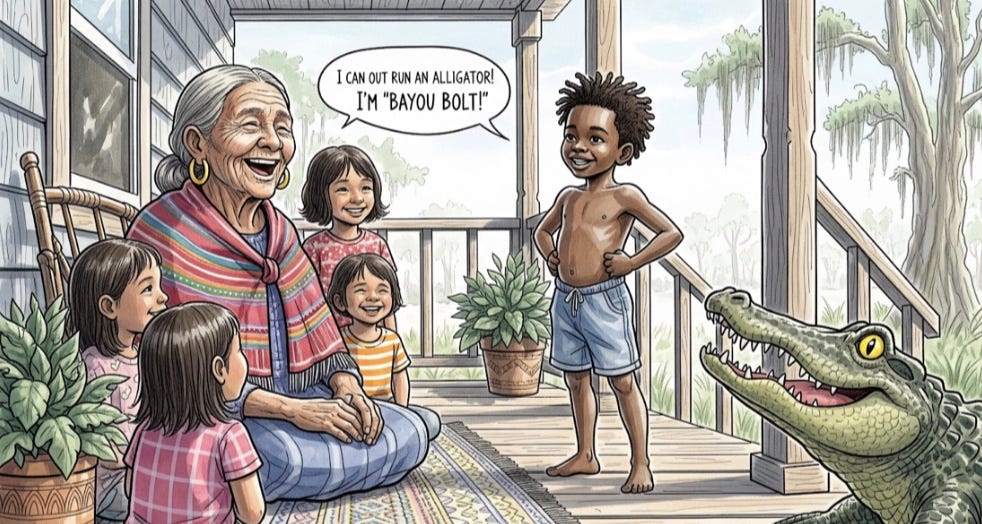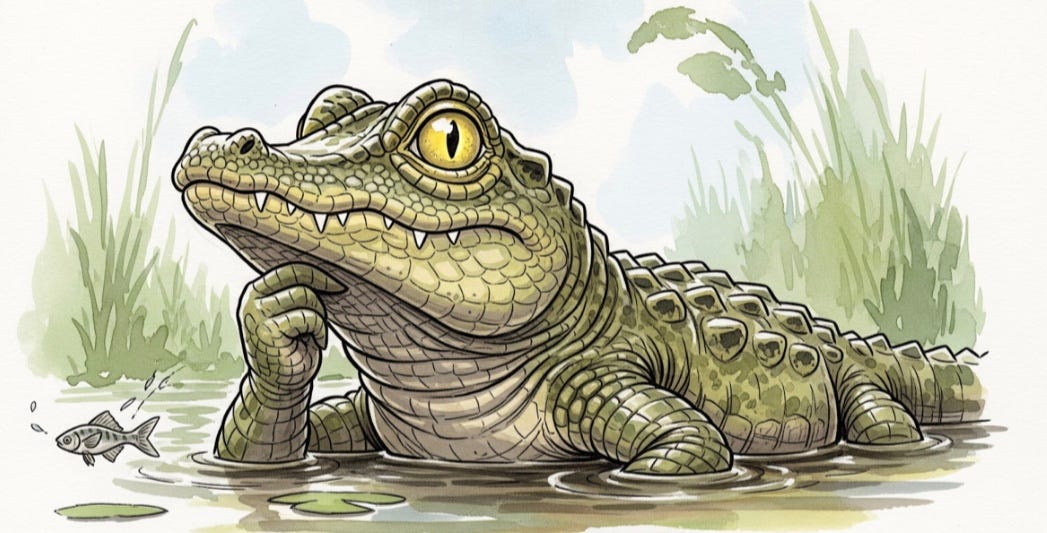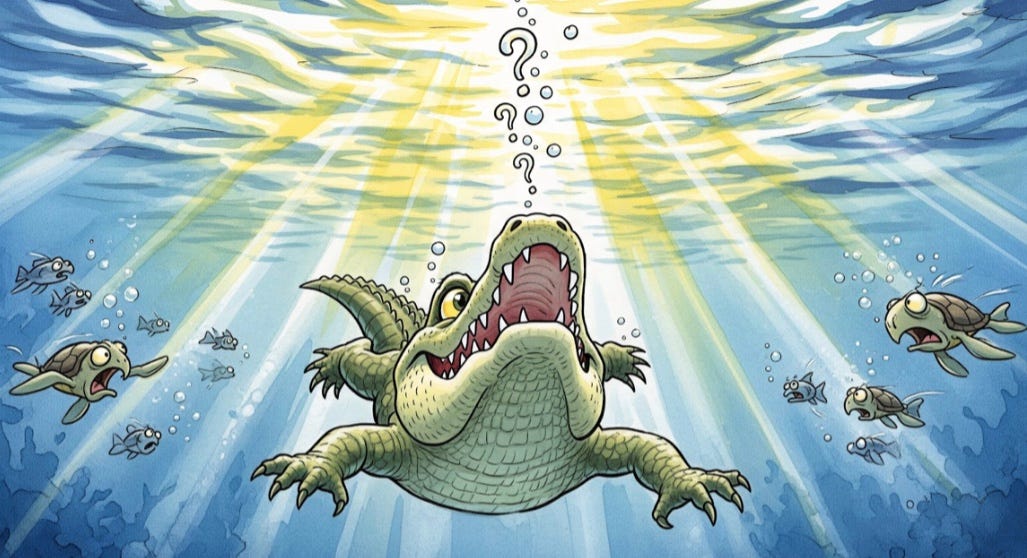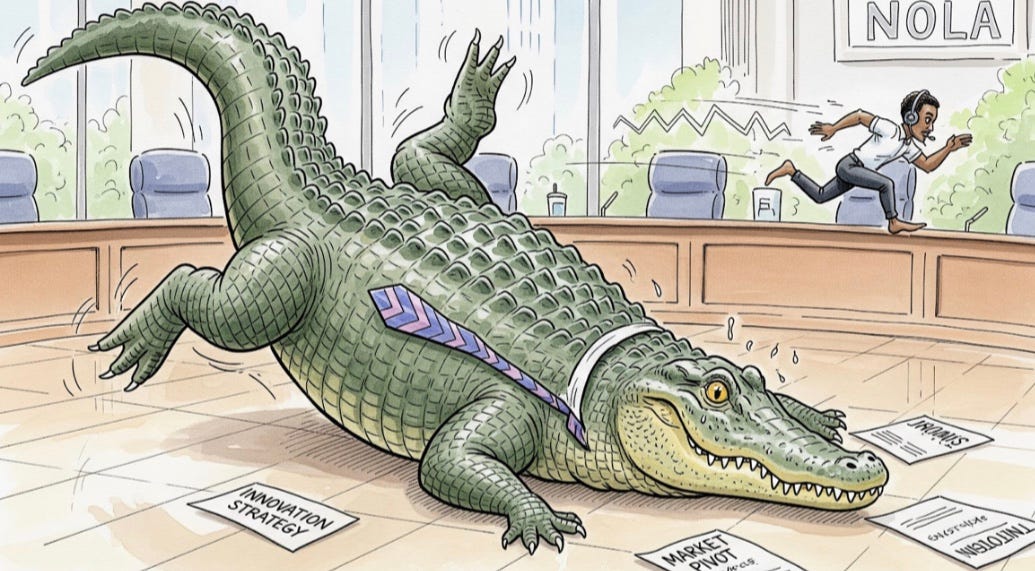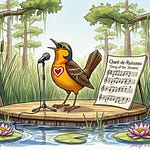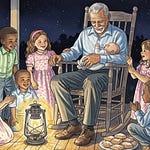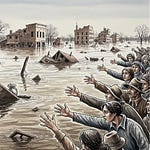CCJC Audio Podcast Episode 000118, Season 2
Laurent (Host): Welcome back to the Cajun Chronicles Podcast Corporation, where the air is thick with mystery and the roux is always thick with flavor! You just heard the sound of our resident audio engineer, Jean Baptiste Vogel, finishing his daily 60-meter dash around the outside of the studio, he uses a trash can lid as a finish line. Sacré.
Jean Baptiste Vogel: Eh, Laurent! It’s not just a daily 100 yard dash! I am preparing! I’m Jean Baptiste, and I know a thing or two about speed, especially short speed.
You know, this whole thing about the gator being 11 to 20 miles per hour over 100 feet? That’s my specialty! It reminds me of when I was a little guy, maybe ten years old, and I was all fired up. I told my neighbor, old Miss Adélaïde, who was part of the Chitimacha family living just down the bayou, “Miss Adélaïde, when I grow up, I’m gonna be a famous track runner! They’ll call me the ‘Bayou Bolt’!”
She’s a real smart lady, once was a school teacher. She just laughed and shook her head, smiled with those kind eyes, and said, “Jean Baptiste, you got long legs, long for you, oui and a good sprint heart. You’ll beat the fastest man. But you listen to the story of Kòchi-Náni.”
Laurent: And that’s the story you’re about to share?
Jean Baptiste: Mais, oui! She told me the tale of the first gator who was too curious for his own good. Miss Adélaïde said, “That alligator, he got the power of a cannon, but he only shoots once. You, Jean Baptiste, you can keep going. Don’t be like the gator who went on land and realized he was built for a belly-slide, not a victory lap.”
She taught me that the gator is a straight-line lunge artist. Me? I’m the master of the quick-turn, the feint, the little fake-out danse! If that evolutionary mistake ever comes for my mixing board, I’ll be in the clear before he can decide which way his big, stiff tail wants to point. It’s a matter of superior locomotion and remembering my roots!
Laurent: (Chuckles) Well, thank you for the highly specific running and mythological advice, Jean Baptiste. Now, let’s get into the fathoms of wet history of curiosity that made the alligator the grumpy swamp-thing he is today.
Here is the Miss Adélaïde tale of Kòchi-Náni! That I learned as a child sitting with her grandchildren, who were my playmates as a child:
The Tale of Kòchi-Náni (Little Alligator)
Listen, my grandchildren, gather close to the fire, where the shadows dance like the spirits of the old swamp cypress. You ask why the kòchi, the alligator. He looks like a muddy log with legs, and that’s why he always has that look of mild regret in his cold, yellow eyes? I’ve seen it and I will tell you my opinion.
This is the tale of Kòchi-Náni, who was, in his time, just a tetrapod, a great-great-great-uncle to all the alligators you see today. Now, this was not the time of the Great Spirit, Kuti-Mánkc, when the Red Swamp Crawfish was sent down to bring up the first mud.
No, this was later, when the mud was settled, the bayous were dug deep, and the world was mostly water, water, and more water. It was a perfect world for the first of our kind. Kòchi-Náni was a magnificent swimmer, sleek and strong.
He ruled his stretch of the murky water,all the fish and the turtles gave him a wide berth. Life was simple, if a bit monotonous. Every day was the same wet, shadowy green, the same cool currents, the same slow-motion glide. Every day the alligator thought about the same things.
“Is this all there is?” he’d sigh dramatically, blowing bubbles that burst like tiny, wet yawns on the surface. “Water, and the ceiling of the Sun? Surely, a life so magnificent as mine deserves a greater stage!”
Now, the world beyond the water was only a rumor. The Sandhill Cranes and the Herons would squawk about the “Dry Place” and the “Green Things That Do Not Float.” Kòchi-Náni was deeply, incurably curious. It was his tragic flaw, a need to know that burned brighter than a summer sun on the back of his proto-scales.
One day, he swam beneath a particularly bright spot, a place where the water was so shallow his big feet kept bumping the muddy bottom. He saw a Grean Blue Heron, that pompous long-legged creature, standing on one foot, preening as if he’d invented balance.
“Le Grand Grignou,!” Kòchi-Náni called up, his voice gurgling with eagerness. “Tell me about the Up-Place! Is it true that you can walk without sinking?”
yes, the world up here has many surfaces. Some are firm, dry, and altogether more dignified than your soupy domain.”
That was it. Kòchi-Náni could not stand the indignity. He had to see this “land” for himself. He found a sloping bank, took a deep breath of water (he hadn’t quite mastered the trick of keeping his nose up yet), and made his decision.
“I am Kòchi-Náni,” he declared to a passing minnow, “and I shall ascend!”
He hauled himself up, a great, wet heave of muscle and existential inquiry.
THUMP.
The world immediately changed for reptile tetrapods like him forever.
First, the air. It was thick and dry and made his throat itch. Second, the ground! It was firm, yes, but it was also rough, poky, and not at all comfortable for a belly made for silt and smooth water.
“Maudute!” he wheezed, tasting dust instead of minnow. “It’s all so hard!”
He took a few experimental steps. His powerful swimming tail, so magnificent in the water, just dragged behind him like a heavy, useless rope, making a loud, unfortunate scraping sound. His limbs, perfectly evolved for a quick, low paddle, were suddenly too short. He had to push and strain for every inch.
The Maître du Poisson Heron burst into loud, squawking laughter. “The grand water-master! Look at him! He waddles like a drunk duck trying to find its nest!“
Kòchi-Náni, his dignity wilting faster than a marsh flower in August, tried to hurry forward. His lungs burned. The sun beat down and made him feel dangerously warm. He managed to drag himself a few clumsy yards before collapsing in a heap, panting, the glorious “Up-Place” offering him only friction and mockery.
That was when Kòchi-Náni saw the truth of the situation. The dry Up- Place was indeed magnificent, vast, and full of different shades of green. But it was not his place. He was built for the cool depths, the silent glide. His curiosity, though satisfied, had led him to a terrible discomfort.
With one final, desperate shove, he turned and slid back down the bank. As he hit the water, the cool embrace was a relief so profound he nearly wept through his eyelids.
From that day, Kòchi-Náni, and all his descendants, knew two things for certain. First, the land is there and it is interesting. But it is also too much work to always be up there.
Secondly, that is why the alligator is built the way he is, a master of the water, a fearsome blur of speed and shadow, but on land, he moves with a slow, grinding caution. He will bask in the sun to feel the heat and remember his journey.
Nothing, however, will change the fact that he will always, always be within an easy, repentant slide of the cool, forgiving water. He needs the water, that he cannot deny.
That is also why, if you catch a gator’s eye, he looks like he’s regretting a rash decision he made about 400 million years ago. He went up there. He saw what was up there. He decided it was fundamentally overrated. He knows what he is. He is a creature of the glorious, liquid South and its waters.
The Laurent Thibodaux Bayou Epilogue
There you have it, our audience, the true, ancient reason why the gator is so quick in the water and so mighty slow to mail his tax forms. He’s been burned by curiosity, and it took him 400 million years to learn his lesson.
Now, you know here’s what I think. I’m your host, Laurent, from the Cajun Chronicles Podcast Corporation, broadcasting live this episode from the heart of NOLA’s near bayou country, which is also currently the parking lot of a surprisingly good New Orleans Original Daiquiris CrawGator daiquiri stand in Metairie.
To me this old Chitimacha story of Kòchi-Náni wasn’t just a tale about a clumsy reptile. It’s a metaphor, cher. It’s a very damp, scaly metaphor for New Orleans living.
Think about it. We’ve all been Kòchi-Náni. We’ve all looked at that “Up-Place,” in one way or another. We live on that dry, hard land, and thought, “Man, I gotta try that.”
Maybe your “Up-Place” was moving to a city where they don’t serve gravy on their fries. Maybe it was not wearing a tie to work every day. Maybe it was trying to take a shortcut across the Mississippi River bridge on the Crescent City Connection (CCC) or the Huey P. Long Bridge during rush hour.
In your head, you’re a magnificent water-master, sleek and full of potential. But the moment you drag yourself onto that strange, unforgiving asphalt of the “Up-Place,” your great tail just starts to scrape, and you realize: “Your gift is your flow, not your friction.”
Your legs are too short for the rat race, your skin is drying out in the corporate sun, and suddenly, you’re not the King of the Water, you’re just another poor soul waddling while the Herons (the tourists, the hustle-and-bustle types) laugh at your magnificent, slow-motion failure.
Here’s a little NOLA-fied life advice, straight from our ancestors and a mildly disappointed ancient reptile: “Know your swamp, and dominate it.” Don’t let curiosity turn into foolishness. You wanna peek at the land? Fine. Pull up for a minute, catch some sun, see the sights. But don’t build your permanent nest there.
If the world outside ain’t got the right amount of butter, the right amount of slow, wet, delicious chaos, and the right amount of Couler avec le courant, cher(Flow with the current, dear, then you simply slide back down!
Go where your gifts shine, where your skin stays supple, and where your greatest effort is a glorious, powerful swim.
That, our listening friends, is how you stay happy in the bayou country. Don’t be a tetrapod of tragedy. Be an alligator of awesome adaptability. Now, go grab yourself a proper drink. Until next time, after a word from our sponsor, Bayou Blast Bug Spray! It repels Herons, keep tuning in.
A Word of Wisdom:
Our fictional and non-fictional tales are inspired by real Louisiana and New Orleans history, but some details may have been spiced up for a good story. While we’ve respected the truth, a bit of creative license could have been used. Please note that all characters may be based on real people, but their identities in some cases have been Avatar masked for privacy. Others are fictional characters with connections to Louisiana.
As you read, remember history and real life is a complex mix of joy, sorrow, triumph, and tragedy. While we may have (or not) added a bit of fiction, the core message remains, the human spirit’s power to endure, adapt, and overcome. Cajun Chronicles Audio Podcast - Bringing you the heart of Louisiana. All artwork generated with Google Docs Image Maker unless otherwise noted.
© Jerilee Wei 2025 All Rights Reserved.




